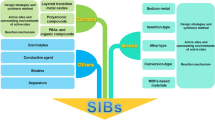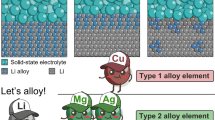Abstract
The growth of lithium dendrite in solid electrolytes has become a major obstacle to the development of solid-state lithium batteries. Lithium dendrite can cause problems such as reduced Coulombic efficiency and shortened lifespan of the battery, and may even cause short circuits that lead to battery failure. The phase field method is used to establish a coupled electro-thermo-mechanical model to study the growth of lithium dendrite, and the plastic behavior of lithium dendrite is also considered. Based on the theory of heat transfer models, the influence of temperature changes on the morphology of lithium dendrite and von Mises stress are analyzed. Using the theory of plastic work, the influence of temperature changes and external pressure changes on the plastic strain of lithium dendrite are analyzed. The results show that the inhibition effect on lithium dendrite is more significant with increasing external pressure and temperature values, and von Mises stress also increases. Lithium dendrite may fracture due to excessive von Mises stress and form dead lithium. The equivalent plastic strain of lithium dendrite increases with the increase of temperature and external pressure values.














Similar content being viewed by others
References
Zhang S, Shen Z, Lu Y (2021) Research progress of thermal runaway and safety for lithium metal batteries. Acta Phys Chim Sin 37(1):2008065
Wang P, Qu W, Song WL et al (2019) Electro–chemo–mechanical issues at the interfaces in solid-state lithium metal batteries. Adv Funct Mater 33(20):1–29
Arguello ME, Labanda NA, Calo V et al (2022) Dendrite formation in rechargeable lithium-metal batteries: phase-field modeling using open-source finite element library. J Energy Storage 53:104892
Wen J, Yu Y, Chen C (2012) A review on lithium-ion batteries safety issues: existing problems and possible solutions. Mater Express 2(3):197–212
Liu Y, Sun J, Hu X et al (2022) Lithiophilic sites dependency of lithium deposition in Li metal host anodes. Nano Energy 94:106883
Chen KH, Wood KN, Kazyak E et al (2017) Dead lithium: mass transport effects on voltage, capacity, and failure of lithium metal anodes. J Mater Chem A 5(23):11671–11681
Kushima A, So KP, Su C et al (2017) Liquid cell transmission electron microscopy observation of lithium metal growth and dissolution: root growth, dead lithium and lithium flotsams. Nano Energy 32:271–279
Bai P, Li J, Brushett FR et al (2016) Transition of lithium growth mechanisms in liquid electrolytes. Energy Environ Sci 9(10):3221–3229
Pei A, Zheng G, Shi F et al (2017) Nanoscale nucleation and growth of electrodeposited lithium metal. Nano Lett 17(2):1132–1139
Li Y, Zhang G, Chen B et al (2022) Understanding the separator pore size inhibition effect on lithium dendrite via phase-field simulations. Chin Chem Lett 33(6):3287–3290
Crowther O, West AC (2008) Effect of electrolyte composition on lithium dendrite growth. J Electrochem Soc 155(11):A806
Bates JB, Dudney NJ, Neudecker B et al (2000) Thin-film lithium and lithium-ion batteries. Solid State Ion 135(1–4):33–45
Aurbach D (2000) Review of selected electrode–solution interactions which determine the performance of Li and Li ion batteries. J Power Sources 89(2):206–218
Li Y, Sha L, Lv P et al (2022) Influences of separator thickness and surface coating on lithium dendrite growth: a phase-field study. Materials 15(22):7912
Dollé M, Sannier L, Beaudoin B et al (2002) Live scanning electron microscope observations of dendritic growth in lithium/polymer cells. Ecs Solid State Lett 5(12):A286
Wang K, Pei P, Ma Z et al (2015) Dendrite growth in the recharging process of zinc–air batteries. J Mater Chem 3(45):22648–22655
Léger C, Elezgaray J, Argoul F (1998) Dynamical characterization of one-dimensional stationary growth regimes in diffusion-limited electrodeposition processes. Phys Rev E 58(6):7700
Brady RM, Ball RC (1984) Fractal growth of copper electrodeposits. Nature 309(5965):225–229
Fleury V, Rosso M, Chazalviel JN et al (1991) Experimental aspects of dense morphology in copper electrodeposition. Phys Rev A 44(10):6693
Sand HJS (1901) III On the concentration at the electrodes in a solution, with special reference to the liberation of hydrogen by electrolysis of a mixture of copper sulphate and sulphuric acid. London, Edinburgh Dublin Philo. Mag J Sci 1(1):45–79
Monroe C, Newman J (2003) Dendrite growth in lithium/polymer systems: a propagation model for liquid electrolytes under galvanostatic conditions. J Electrochem Soc 150(10):A1377
Barton JL, Bockris JOM (1962) The electrolytic growth of dendrites from ionic solutions. Proc Math Phys 268(1335):485–505
Brissot C, Rosso M, Chazalviel JN et al (1999) Dendritic growth mechanisms in lithium/polymer cells. J Power Sources 81:925–929
Rosso M, Brissot C, Teyssot A et al (2006) Dendrite short-circuit and fuse effect on Li/polymer/Li cells. Electrochim Acta 51(25):5334–5340
Verma A, Kawakami H, Wada H et al (2021) Microstructure and pressure-driven electrodeposition stability in solid-state batteries. Cell Rep Phys Sci 2(1):100301
Chen L (2016) Integrating first-principle calculation and phase-field simulation for lithium dendritic growth on the anode of a lithium-ion battery. ASME Int Mech Eng Congr Expo Am Soc Mech Eng 50633:V009T12A076
Zhang R, Shen X, Cheng XB et al (2019) The dendrite growth in 3D structured lithium metal anodes: electron or ion transfer limitation? Energy Stor Mater 23:556–565
Yamakawa S, Okazaki-Maeda K, Kohyama M et al (2008) Phase-field model for deposition process of platinum nanoparticles on carbon substrate. J Phy: Conf Ser 100(7):072042
Zhou S, Zhuang X, Zhu H et al (2018) Phase field modelling of crack propagation, branching and coalescence in rocks. Theor Appl Fract Mech 96:174–192
Fei F, Choo J (2020) A phase-field method for modeling cracks with frictional contact. Int J Numer Meth Eng 121(4):740–762
Steinke C, Kaliske M (2019) A phase-field crack model based on directional stress decomposition. Comput Mech 63(5):1019–1046
Wise S, Kim J, Lowengrub J (2007) Solving the regularized, strongly anisotropic Cahn-Hilliard equation by an adaptive nonlinear multigrid method. J Comput 226(1):414–446
Kobayashi R (1993) Modeling and numerical simulations of dendritic crystal growth. Physica D 63(3–4):410–423
Penrose O, Fife PC (1990) Thermodynamically consistent models of phase-field type for the kinetic of phase transitions. Physica D 43(1):44–62
Karma A, Rappel WJ (1998) Quantitative phase-field modeling of dendritic growth in two and three dimensions. Phys Rev E 57(4):4323
Liang L, Qi Y, Xue F et al (2021) Nonlinear phase-field model for electrode-electrolyte interface evolution. Phys Rev E 86(5):051609
Martin W, Tian Y, Xiao J (2021) Understanding diffusion and electrochemical reduction of Li+ ions in liquid lithium metal batteries. J Electrochem Soc 168(6):060513
Takahashi M, Watanabe T, Yamamoto K et al (2021) Investigation of the suppression of dendritic lithium growth with a lithium-iodide-containing solid electrolyte. Chem Mater 33(13):4907–4914
Sun ZT, Zhou J, Wu Y et al (2022) Mapping and modeling physicochemical fields in solid-state batteries. J Phys Chem Lett 13(46):10816–10822
Placke T, Kloepsch R, Dühnen S et al (2017) Lithium ion, lithium metal, and alternative rechargeable battery technologies: the odyssey for high energy density. J Solid State Electrochem 21:1939–1964
Xia S, Wu X, Zhang Z et al (2019) Practical challenges and future perspectives of all-solid-state lithium-metal batteries. Chem 5(4):753–785
Wu Z, Xie Z, Yoshida A et al (2019) Utmost limits of various solid electrolytes in all-solid-state lithium batteries: a critical review. Renew Sust Energ Rev 109:367–385
Cao D, Sun X, Li Q et al (2020) Lithium dendrite in all-solid-state batteries: growth mechanisms, suppression strategies, and characterizations. Matter 3(1):57–94
Wu H, Xu Y, Ren X et al (2019) Polymer-in-“quasi-ionic liquid” electrolytes for high-voltage lithium metal batteries. Adv Energy Mater 9(41):1902108
Kerman K, Luntz A, Viswanathan V et al (2017) Practical challenges hindering the development of solid state Li ion batteries. J Electrochem Soc 164(7):A1731
Lewis JA, Tippens J, Cortes FJQ et al (2019) Chemo-mechanical challenges in solid-state batteries. Trends Chem 1(9):845–857
Ke X, Wang Y, Dai L et al (2020) Cell failures of all-solid-state lithium metal batteries with inorganic solid electrolytes: lithium dendrites. Energy Stor Mater 33:309–328
Chen Y, Jiang Y, Chi SS et al (2022) Understanding the lithium dendrites growth in garnet-based solid-state lithium metal batteries. J Power Sources 521:230921
Zhao B, Ma W, Li B et al (2022) A fast and low-cost interface modification method to achieve high-performance garnet-based solid-state lithium metal batteries. Nano Energy 91:106643
Deng T, Ji X, Zhao Y et al (2020) (2020) Tuning the anode–electrolyte interface chemistry for garnet-based solid-state Li metal batteries. Adv Mater 32(23):2000030
Yan HH, Bie YH, Cui XY et al (2018) A computational investigation of thermal effect on lithium dendrite growth. Energy Convers Manag 161:193–204
Aryanfar A, Brooks D, Merinov BV et al (2014) Dynamics of lithium dendrite growth and inhibition: pulse charging experiments and Monte Carlo calculations. J Phys Chem Lett 5(10):1721–1726
Mayers MZ, Kaminski JW, Miller TF III (2012) Suppression of dendrite formation via pulse charging in rechargeable lithium metal batteries. J Phys Chem C 116(50):26214–26221
Vishnugopi BS, Hao F, Verma A et al (2020) Double-edged effect of temperature on lithium dendrites. Acs Appl Mater Inter 12(21):23931–23938
Hwang J, Okada H, Haraguchi R et al (2020) Ionic liquid electrolyte for room to intermediate temperature operating Li metal batteries: dendrite suppression and improved performance. J Power Sources 453:227911
Love CT, Baturina OA, Swider-Lyons KE (2015) Observation of lithium dendrites at ambient temperature and below. ECS Electrochem Lett 4(2):A24
Ren Y, Zhou Y, Cao Y (2020) Inhibit of lithium dendrite growth in solid composite electrolyte by phase-field modeling. J Phys Chem C 124(23):12195–12204
Shi S, Gao J, Liu Y et al (2016) Multi-scale computation methods: their applications in lithium-ion battery research and development. Chin Phys B 25(1):018212
Chen L, Zhang HW, Liang LY et al (2016) Modulation of dendritic patterns during electrodeposition: a nonlinear phase-field model. J Power Sources 300:376–385
Shen X, Zhang R, Shi P et al (2021) How does external pressure shape Li dendrites in Li metal batteries? Adv Energy Mater 11(10):2003416
Cahn JW, Allen SM (1977) A microscopic theory for domain wall motion and its experimental verification in Fe-Al alloy domain growth kinetics. J Phys 38(C7):C7–51–C7–54
Allen SM, Cahn JW (1979) A microscopic theory for antiphase boundary motion and its application to antiphase domain coarsening. Acta metall 27(6):1085–1095
Wu W, Xiao X, Huang X (2012) The effect of battery design parameters on heat generation and utilization in a Li-ion cell. Electrochim Acta 83:227–240
Doyle M, Newman J, Gozdz AS et al (1996) Comparison of modeling predictions with experimental data from plastic lithium ion cells. J Electrochem Soc 143(6):1890
Fang J, Wu C, Rabczuk T et al (2019) Phase field fracture in elasto-plastic solids: Abaqus implementation and case studies. Theor Appl Fract Mech 103:102252
LePage WS, Chen Y, Kazyak E et al (2019) Lithium mechanics: roles of strain rate and temperature and implications for lithium metal batteries. J Electrochem Soc 166(2):A89–A97
Funding
This work is supported by Sichuan Science and Technology Program (Grant Nos. 2023NSFSC0394 and 2023NSFSC1988).
Author information
Authors and Affiliations
Corresponding author
Ethics declarations
Conflict of interest
The authors declare no competing interests.
Additional information
Publisher's Note
Springer Nature remains neutral with regard to jurisdictional claims in published maps and institutional affiliations.
Rights and permissions
Springer Nature or its licensor (e.g. a society or other partner) holds exclusive rights to this article under a publishing agreement with the author(s) or other rightsholder(s); author self-archiving of the accepted manuscript version of this article is solely governed by the terms of such publishing agreement and applicable law.
About this article
Cite this article
Yang, H., Wang, Z. Effects of pressure, temperature, and plasticity on lithium dendrite growth in solid-state electrolytes. J Solid State Electrochem 27, 2607–2618 (2023). https://doi.org/10.1007/s10008-023-05560-4
Received:
Revised:
Accepted:
Published:
Issue Date:
DOI: https://doi.org/10.1007/s10008-023-05560-4




